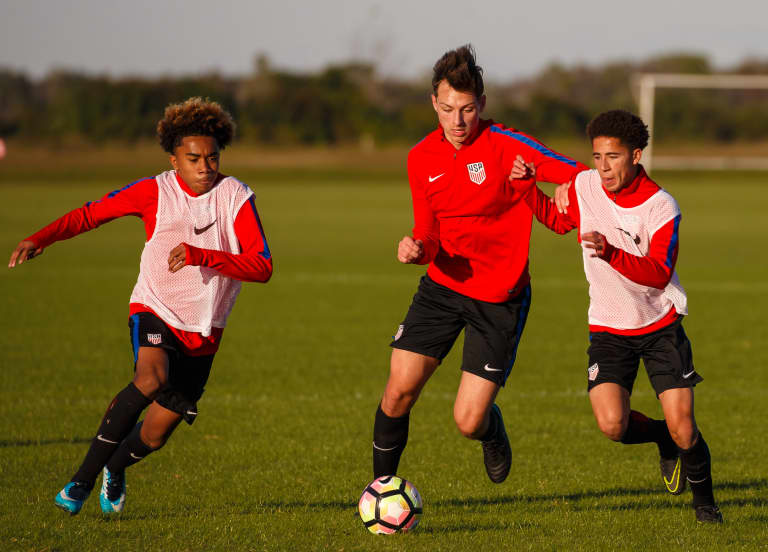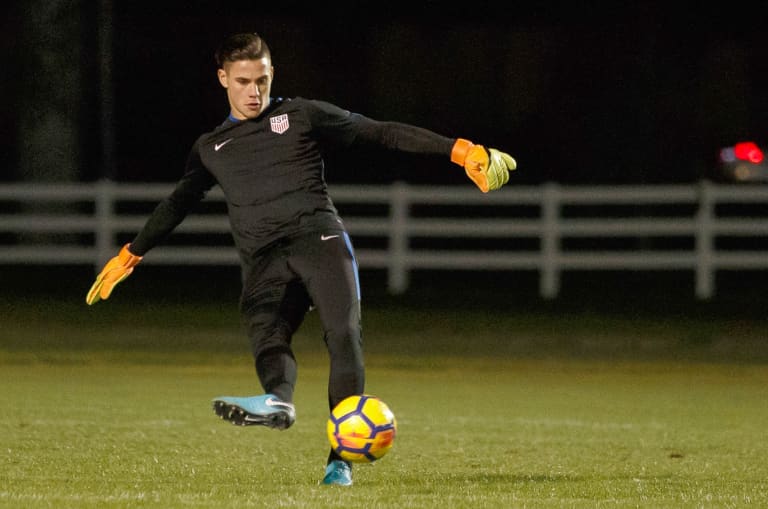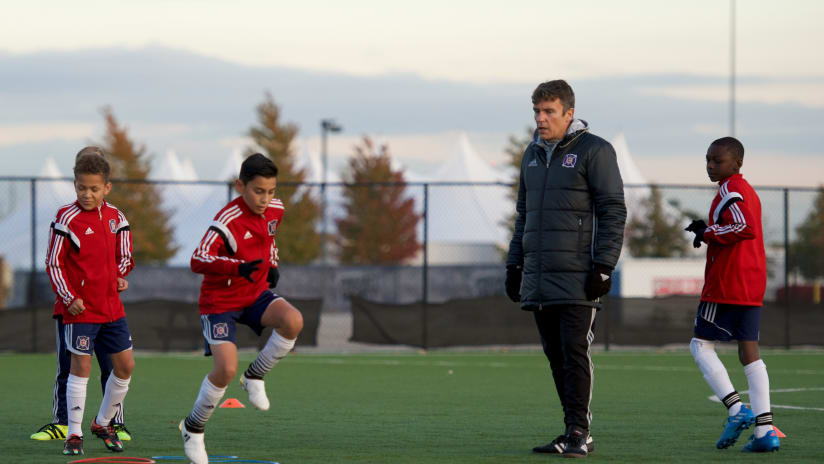On Dec. 29, it was announced that four of the Chicago Fire Academy's brightest prospects would head to Lakewood Ranch, Fla. during the first weeks of January to take part in U.S. Soccer's first-ever Youth National Team Summit under the guidance of U.S. Soccer's Youth Technical Director Tab Ramos.
The four players -- U-1
7
defenders
David
Mendoza and Nick Slonina, U-17 goalkeeper Damian Las, and U-1
5
midfielder Javier Casas -- were part of an integration between players, coaches and staff from U.S. Soccer's five oldest Youth National Teams to help lay the first foundational elements for qualifying the U.S. for the 2019 FIFA U-20 and U-17 World Cups (according to U.S. Soccer).
For Chicago Fire Academy Technical Director Cedric Cattenoy, the players' respective experiences with the national team and continued inclusions (should they earn them) help serve as an on-going benchmark for the academy's progress.

Nick Slonina (center) fights for possession during USMNT U-18 training on Jan. 4, 2018. (Casey Brooke Lawson, ISI photos)
"It’s an honor for the club to have young players with the national team," Cattenoy said. "That means our development program is coherent and efficient. For the players, it’s a really big opportunity to train and to play with the top players in the country and maybe to play international games.”
"Being called in to national team camp motivates me,” Casas said upon his return to Chicago. “The only way I can get called again is if I keep working twice as hard. When I see those emails about getting called in, I gain more confidence in myself to keep striving to be my best."
In addition to the quartet of Fire academy products selected to the YNT Summit, a pair of U-1
4
s -- Justin Reynolds and Gabriel Slonina — are beginning their 2018 national team involvement by attending a U.S. Youth Soccer domestic training camp held Jan. 13-20 in Sunrise, Fla. The six academy players involved with the national team
s
are a good start according to Cattenoy, but are also just that: a start.
"It’s a very good experience for them to build their background and to be able to play in the top games," Cattenoy said. "But, for me, in the future we need to have
at least
two or three players in each
national team
age group. To reach this goal, we need to have a good scouting department and to continue to work with a coherent development program. When you have two or three players in each generation, it’s a good start for the academy. It’s a good sign."
To achieve that goal, Cattenoy and
his staff
continue to emphasize the areas of development they believe will best prepare their players for increased levels of competition. First and foremost among those areas is simply a greater exposure to the international game itself.
"A key objective of our academy program is to give players a global futbol education,” said
Brian Roberts, Academy Director of Performance, Advisory and Support Services
. “We believe challenging ourselves against accomplished international teams is one if the ways we can do this. This year our 2004 age group will travel to Montreal and our 2003 age group will travel to Dallas Cup to compete against teams that we don’t regularly play against in the U.S. Soccer Development Academy league. Combining USSDA competition with games against international teams will teach our teams to adapt to varied styles of play and enhance their global futbol experience."

Damien Las trains with the USMNT U-18 team on Jan. 3, 2018. (Casey Brooke Lawson, ISI photos)
The Academy has altered its curriculum to emphasize a holistic approach to educating its young athletes, central to which are
personal development plans -- or PDPs — to enhance and accelerate each player’s growth based on their respective strengths and weaknesses.
”An important feature of the PDPs are player participation pathways,” Roberts said. “For example it is common for players to play up an age group in order to challenge them on an individual level. David Mendoza is a 2001 player but he is now participating in practices and games fulltime with 1999 and 2000 age groups."
Outside of Mendoza, both Sloninas, Las, Casas, and Reynolds, a further 16 players will attend the U.S. Soccer Training Center on Jan. 17, giving the academy a total of 22 players involved with national team activities this month alone.
With upcoming friendlies on the docket, Generation Adidas Cup play resuming in February, and Development Academy play starting back up this Spring, Cattenoy and co. will be leaning on their national teamers to help provide a cyclical form of growth and experience for other players in the academy as well.
"Playing with the national team is a very big experience," Cattenoy said. "When they come back, they have to bring something more to the club. It’s a cycle. We develop them, we help them to go there, and when they come back they have something to bring and to share. They are good examples for the other players.”
"The responsibilities I feel I have to the academy are to be a role model,” Casas added. “(One) who is respectful, is focused, and is eager to learn. A leader who motivates other players through my work ethic on the field and has a positive influence off the field as well."
Follow the Chicago Fire Academy as they get their 2018 underway on Twitter at @ChiFireAcademy and on Facebook at ChiFireAcademy.





